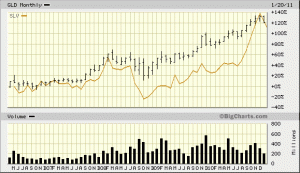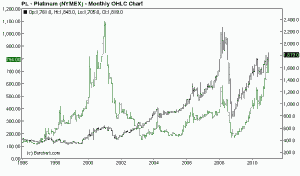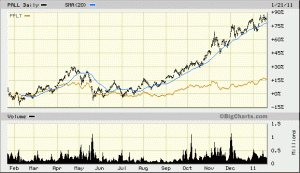Investing In Metals – Which Metal Is The Best To Buy?
If there is anything that investors should have learned in the past decade it’s that commodities (which include metals) have a place in a well diversified portfolio. When it comes to investing in the metals, investors have traditionally favored Gold, Silver and Platinum. However, in recent years the more industrial metals Palladium and Copper have increasingly found their ways into investor portfolios.
Those who believe the monetary system is on the verge of collapse will tell you the only reasonable thing to do is purchase the physical metal and bury it somewhere safe. At this point I’m not convinced the end is at hand so I choose to use ETFs for my investing. Today after the metals have had such a big run there is much more downside risk which is another reason I use ETFs. It’s much easier to get out of an ETF when the time comes to sell. Most current investors didn’t buy gold or silver in 1980 so they don’t know what it feels like to go through a 20 year bear market. Many who bought physical metal back then (especially silver) are just now getting back to break even.
Gold Versus Silver
If you look back over the past 6 or 7 years you can see that Gold and Silver price performance was almost identical leading up to the credit crunch / recession. Coming out of the crisis Gold performed much better because it is more influenced by investment demand and less by industrial demand. In general, this out-performance creates a gap known as divergence. When two markets that normally trade together are not, this divergence creates opportunity.
This chart is a compares the Gold ETF – GLD and the Silver ETF – SLV from April 2006 – January 2011. You can clearly see that as late as July 2010 that gold was up over 100% in that time frame but silver was only up 40%. When gold began to break out to the upside in early August that was an indication to buy silver as we discussed in a previous article.
Platinum VS. Palladium
A similar situation occurs with Platinum and Palladium but they tend to take several years to play out. Since both metals are heavily used as industrial metals they tend to move more with the business cycle. Since both have similar properties there is a strong substitution effect that takes place between the two metals. By looking at the chart below you can see that the pendulum swung in favor of Palladium (rising nearly 10 fold) from 1996 until mid-2000 when the economy began to tank.
Coming out of the 2001-2002 recession Platinum was the metal of choice because many industrial applications had switched back to platinum due to the sharp rise in palladium prices. As you can see Platinum rose from $400 per ounce to $2200 between 2001 and 2008. When everything collapsed during the credit crunch both platinum and palladium suffered but palladium went back to the lows of 2002 whereas platinum prices bottomed out at twice the 2002 level.
This created an opportunity to invest in palladium and even though both metals have bounced from their low it’s very apparent that palladium has been closing the gap with platinum. In fact, in 2010 you can see that palladium dramatically outperformed platinum.
Looking at this chart you can see how dramatic the out-performance has been the past year, the Platinum ETF – PPLT is the worst performing of all metals in 2010. Based on the long term chart this trend could continue until Palladium once again becomes over valued compared to the price of Platinum. However, since the Palladium ETF – PALL was up over 80% in the past year I would definitely be afraid to jump in right here.
The point of this article is just to show you that the best metal to buy is the one that has been out of favor. When normal relationships get stretch to an extreme one way or another it provides low risk, high reward opportunities. Then you can profit as the otherwise normal relationships move back toward their long term equilibrium.



